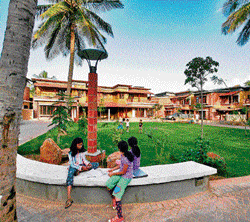Good Earth Malhar envisages a neighbourhood filled with a group of likeminded people who will take the idea of sustainability forward. Here, everyone must share pride, and a sense of caring for the earth.

A sustainable neighbourhood is one which creates spaces for the soul. It is where the individual home is integrated into a community, at a scale which is village-like. The sharing of open spaces, amenities, renewable resources and, most importantly, values becomes the core of the community.
In this context, it is important for every participant in the process to be proactive, committed and involved.
From the user to the skilled craftsman, the unskilled labourer to the architect, the engineer to the maintenance person, all must share a pride, a sense of caring for the earth, and realise the importance of each one’s role in the entire development. Good Earth Malhar is such a community.
Malhar is an ecovillage spread over 50 acres of land, which will be developed in a phased manner. The vision is to create a neighbourhood of a group of likeminded people who will take the idea of sustainability forward.
The plan is to create a rich variety of spaces to complement the homes - open spaces, playgrounds, parks, sports facilities, spaces to encourage theatre and cultural activities, markets, maybe medical and childcare facilities.
Home-based enterprises which share skills and enrich the neighbourhood are a path to realising the sustainable dream.
The 50-acre township will be divided into primary, secondary and overall neighbourhood groups, the primary group being the intimate cluster of 12-16 homes, the secondary a larger group of 50 to 100 homes and the neighbourhood group being about 500-600 homes.
The groups will be created according to the typology of the homes and the layout of the specific cluster.
Features of Good Earth Malhar Planning
Designed for the pedestrian and not the car, the plan creates pedestrian-only spaces connected through interesting pathways.
Conveniences such as trolleys and electric vehicles to take care of carrying luggage and for the elderly to move around will be taken care of.
Public spaces such as playgrounds, amphitheatres and rain-fed water bodies, will serve as platforms to transfer oral and visual traditions to the next generation are integrated into the planning.
The plan evokes closeness to nature, and a more human scale, by building low rise and letting each individual have access to land, which he/she can take care of, feel and touch.
The plan responds to the natural lay of the land, using the features on the land to enhance the spaces and conserve the natural elements.
Design
The architecture advocates comfort without opulence, not forgoing the fact that our work and life is a celebration of nature and earth.
The spaces respond to basic requirements, but encourage multi-use and are culture-sensitive. They prompt values of conservation through adequate light and ventilation and economy of design.
The materials and techniques can be conveniently sourced and used in their natural form, are renewable and use minimum energy in their production. Integrating craft and reinventing aesthetics which are honest in their expression defines the choices.
The technology should question the values in “green” as it is understood by the world today.
Green technology comes after green design - one does not look for green solutions to problems that are created by an insensitive design, instead of taking the effort within the design to create comfortable spaces.
Environment
Water is one of the most valuable resources today, and will be scarce in the future. The water management at Malhar works towards being water independent, by harvesting rainwater and recycling waste water. The space and the finances required to implement these are a priority in our design.
Other steps being taken include:
Conserving and rejuvenating existing features like water bodies, streams, indigenous trees to enhance the environment and create bird and insect habitats, which will also create awareness about the importance of the environment.
The creation of quiet groves, which can evolve over years as untouched natural habitats, for us to experience the earth and for meditation. Composting biodegradable solid waste and creating options for plastic within the community, thus reducing the use of non-biodegradable material. Sourcing household chemicals which are not harmful to the earth, and facilitating enterprises which will meet the demands of the community.
Neighbours
Finally, any new development must involve the local community, which has been part of the neighbourhood long before the new members.
Creating employment, encouraging local farmers by purchasing their produce, integrating the local community in the use of public spaces, cultural events, will benefit not only the local community, but also impart a more balanced sense of community for our children.
Small scale enterprises, playschool, child care, health care, tailoring, food and such support functions for the community must be encouraged from the members of the community, as also farming, and cultural activities.
These spaces will only form a canvas on which community life can be crafted; the rest needs the collective motivation, skill and will of the community to meet the many challenges to make Good Earth Malhar a model of development for the future.
Good Earth Malhar is located off Mysore Road in Kengeri, Bangalore. Phase 1- Footprints, has begun construction and is expected to finish early next year. Phase 2- Resonance, will begin construction in May. Contact sales@goodearth.org.in or at 9686676504, 9945241616. www.goodearth.org.in